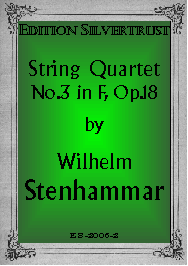Presents
Wilhelm Stenhammar
String Quartet No.3 in F Major, Op.18
 Some critics have
argued that Stenhammar's set of six string quartets is the most important
written between those of Brahms and Bartok. Whether this is so or not, there is
no denying that Stenhammar's quartets represent a very important development
during the twenty five years he was writing chamber music. Tonally, they range
from the middle late Romantics to mature Sibelius. Though not unknown by the
Swedish chamber music public, his string quartets have been sadly neglected
elsewhere.
Some critics have
argued that Stenhammar's set of six string quartets is the most important
written between those of Brahms and Bartok. Whether this is so or not, there is
no denying that Stenhammar's quartets represent a very important development
during the twenty five years he was writing chamber music. Tonally, they range
from the middle late Romantics to mature Sibelius. Though not unknown by the
Swedish chamber music public, his string quartets have been sadly neglected
elsewhere.
Stenhammar (1871-1927) was trained as a pianist, became a virtuoso and was considered the finest Swedish pianist of his time. Concert pianists who venture into the realm of the string quartet often wind up writing compositions which sound like they were composed at, and are perhaps better played at, the piano. This is certainly a valid criticism of some of the quartet writing of both Schumann and Mendelssohn. That Stenhammar's works show no such trait is due entirely to the fact that for nearly half of his life, he worked intimately with the Aulin Quartet, the top Swedish string quartet of its day and one of the best then performing in Europe. In fact, he toured throughout Europe with them for many years and a piano quintet was nearly always featured on their programs. Thus it is no accident that his quartets show a fine grasp of instrumental timbre and technique. The part writing is sure and evenly distributed with the instruments never being asked to perform in a non-violinistic manner.
Stenhammar was not what the Germans call a "Vielschreiber", writing only some 45 works. Of the various genre in which he composed, none occupied him more than that of the string quartet and, they are, to be sure, among his finest works.
By his third quartet, which was completed in 1904, Stenhammar's own voice had fully emerged. Of the Third Quartet, Wilhelm Altmann, the famous chamber music critic has written,
"I warmly recommend this work to every professional string quartet before the public."
Its lovely, tranquil opening movement, Quasi andante, is followed by a breathtaking Presto agitato, It begins full of fire but there are somber interludes of doubt, of "night thoughts". The Presto is linked to a powerfully brilliant and beautiful fugue. Next is a Lento sostenuto, which are a set of highly lyrical and emotional variations. The finale, Presto molto agitato, is a kind of fantasia and fugue. In it we hear haunting echoes of what has come before. This is a masterpiece by any standard which belongs in the concert repertoire.
Parts: $24.95